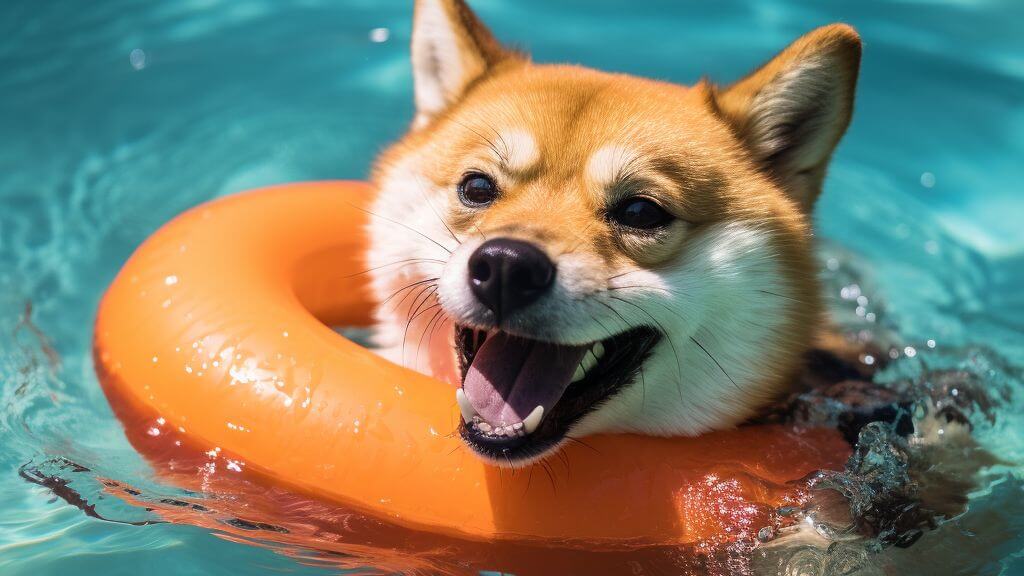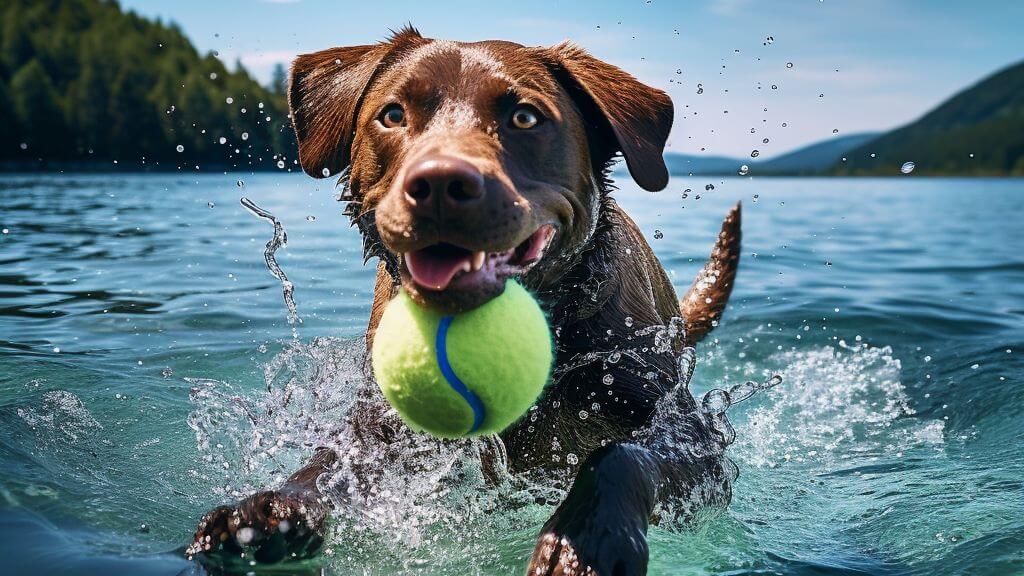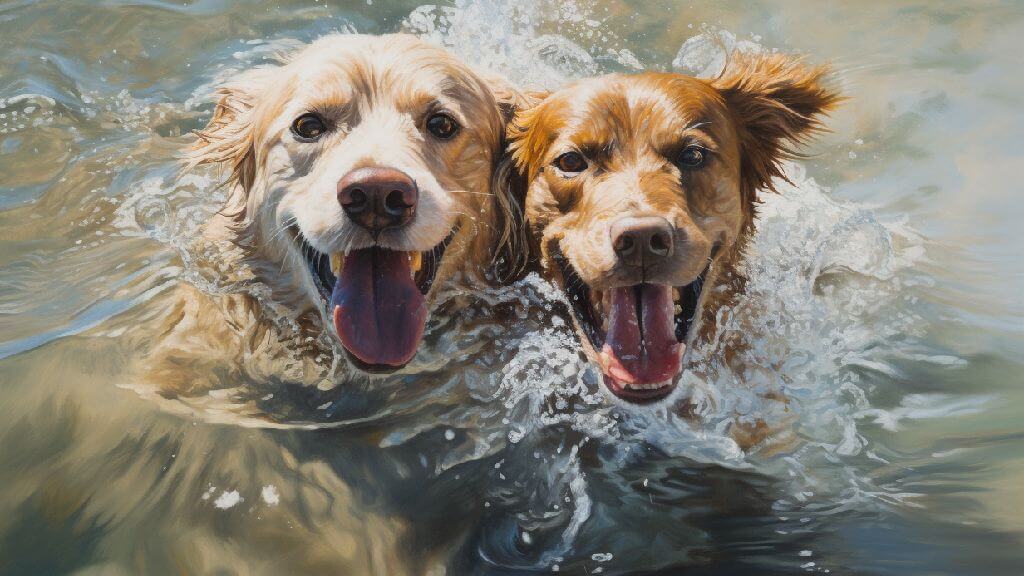Welcoming you to the fascinating world of dogs and water, we delve into the age-old question: Can all dogs swim? Let’s uncover swimming for dogs, understanding the factors influencing their relationship with water.
Can All Dogs Swim?
While many dogs have a natural swimming instinct, it’s a misconception that all dogs are born water enthusiasts. Breed, individual temperament, and past experiences significantly impact a dog’s affinity for the water.
Some breeds are natural swimmers, embracing the water effortlessly; others may need gentle encouragement and guidance.
Understanding 6 Different Breeds and Their Swimming Abilities
Unravel the swimming prowess of six distinct dog breeds. Each breed brings a unique splash from natural water lovers to the pool of canine aquatic abilities.
1. Labrador Retriever
Known for their love of water, Labradors are often natural swimmers. Their webbed feet and water-resistant coat make them excellent aquatic athletes.
2. English Bulldog
Bulldogs, with their compact build, are not natural swimmers. While some may enjoy a splash, their physique can pose challenges. Caution and support are crucial when introducing Bulldogs to water.
3. Dachshund
The elongated body of Dachshunds doesn’t scream ‘swimmer,‘ but many enjoy the water. However, their short legs and unique body shape may be less efficient than water-loving breeds.
4. Greyhound
With a slim build and thin coat, Greyhounds are not built for water adventures. While some may tolerate it, caution should be exercised, and swimming sessions should be brief.
5. Chesapeake Bay Retriever
Known as the “water dog,” Chesapeake Bay Retrievers are exceptional swimmers. Their love for water and endurance naturally fit them for aquatic activities.
6. Basset Hound
With their low-slung bodies and short legs, Basset Hounds are not typically drawn to water. However, with patient introduction and positive reinforcement, some may like swimming.

7 Steps of Teaching Dogs to Swim
Here’s a step-by-step guide to help your canine companion embrace the joy of swimming:
Teaching a dog to swim involves patience, understanding, and a strategic approach. Not every pup will eagerly leap into the water, and that’s perfectly normal.
- Building Trust and Confidence
Before venturing into the water, build trust with your dog. Spend time near the water, allowing them to observe and sniff their surroundings.
- Choose the Right Location
Select a calm, shallow water source for your dog’s first swimming experience. A surface area with a gradual entry, such as a dog-friendly beach or a quiet lake, is ideal.
- Gradual Introduction to Water
Start in shallow, calm waters where your dog can wade comfortably. Please encourage them to enter at their own pace, using toys or treats as motivation.
- Use a Canine Life Jacket
Consider using a canine life jacket for safety, especially if your dog is new to swimming. A life jacket provides buoyancy and helps build confidence.
- Positive Reinforcement
Encourage your dog with positive reinforcement techniques. Use treats, toys, and verbal praise to reward them for entering the water and paddling.
- Practice Swimming Commands
Teach your dog basic swimming commands such as “come,” “stay,” and “swim.” This helps you maintain control and ensures a safe swimming experience. Practice these commands on land and water, gradually increasing the distance.
- Monitor Your Dog’s Comfort Level
Pay close attention to your dog’s body language and comfort level. If your dog seems stressed or anxious, take a step back and allow them time to acclimate.

Real-Life Tails: Stories of Canine Aquatic Adventures
Our tale begins with patience and empathy as the dedicated pet parent seeks to understand and address the fears gripping their furry companion. Here, “teaching dogs to swim” takes on profound meaning as the dog’s trust is patiently earned.
- Gradual Progress: Small Steps, Big Triumphs
Through positive reinforcement, tasty treats, and reassuring words, the reluctant swimmer starts taking small, hesitant steps into the water.
Each triumph, no matter how minor, becomes a cause for celebration. It’s a journey of overcoming fears and building confidence, a testament to the bond between humans and canines.
- The Turning Point: A Splash of Courage
As the days pass, our once-reliant swimmer finds the courage to swim freely. The fear that once lingered in their eyes transforms into a glint of excitement. The journey from fear to joy is complete, marking a heartwarming chapter in the canine aquatic adventure book.
- The Natural Swimmer: When Instinct Takes the Lead
Contrasting the reluctant swimmer is the natural swimmer, a canine born with an innate love for water. These are the dogs that, upon encountering a body of water, don’t hesitate to dive right in. Their passion for swimming seems ingrained in their DNA, a delightful trait that often surprises owners and onlookers.
- Instinct Unleashed
For the natural swimmer, teaching them to swim is less about overcoming fear and more about tapping into their inherent abilities. From a young age, these dogs showcase an affinity for water, effortlessly navigating through lakes, rivers, and backyard pools.
- Embracing the Joy of Water
The natural swimmer finds pure joy in aquatic activities. Their human companions in underwater adventures are marked by enthusiasm and an unmistakable love for everything wet.
- Water Safety
While these dogs may be born swimmers, ensuring their safety is crucial. Introducing life jackets for excursions in deeper waters or during water sports is a responsible measure; providing their love for swimming doesn’t compromise their well-being.
- Surfing, Dock Diving, and Beyond
Once a dog becomes comfortable in the water, the possibilities for aquatic adventures expand. Canine water sports, ranging from surfing to dock diving, showcase the athleticism and agility of our four-legged friends.
- Leaping into Adventure
Dock diving takes canine water sports to new heights, literally. Dogs are trained to sprint down a dock and launch into a pool, competing to see who can achieve the farthest distance.
It’s an exhilarating display of strength and agility, proving that our furry companions are more than just paddlers. They’re dynamic athletes in the aquatic arena.
- Underwater Exploration
While not as mainstream, some adventurous pet parents have taken water activities to the next level. With specially designed equipment and careful training, dogs can explore the underwater world alongside their human counterparts, creating a unique and unforgettable bond.
The art of teaching dogs to swim is a patient and rewarding journey, strengthening the bond between humans and their canine counterparts.
Conclusion
All dogs have a different and unique relationship with water. Understanding the breeds that may face challenges in the water equips us with the knowledge needed for responsible and enjoyable aquatic adventures.
So, If your dog is a natural-born swimmer or needs a bit of encouragement, embrace the aquatic world together and celebrate the joy of swimming.

FAQs
How do you know if a dog can swim?
Watch for natural interest; a dog can show curiosity around water, display paddling motions, or willingly enter shallow areas; it may have a natural inclination for swimming.
How long should dogs be allowed to swim?
Monitor energy levels: Dogs vary, but a good rule is 10-30 minutes. Pay attention to signs of fatigue, and always provide breaks to prevent exhaustion.
Can dogs swim with humans?
Many dogs enjoy swimming alongside their human companions. Ensure a safe environment, use a leash if needed, and be mindful of the dog’s comfort level.
Why do dogs swim in water?
Instinct and pleasure: Some dogs swim for joy, exercise, or to cool down. Breeds with water-related instincts, like Retrievers, may swim to fulfill their natural tendencies.
Does Swimming help dogs?
Swimming is a low-impact exercise that benefits dogs’ joint health, muscle tone, and cardiovascular fitness. It’s beneficial for older dogs or those with common issues.
Can dogs swim in oceans?
While some dogs love ocean swims, be mindful of tides, currents, and saltwater. Introduce gradually, use a life jacket if needed, and rinse off afterward to remove salt.
Can dogs swim in the bath?
Dogs can swim in the bath, but it’s a different experience compared to larger bodies of water. While some dogs may enjoy bath time, others might feel uneasy. Use lukewarm water and a non-slip mat, and introduce positive associations with treats or toys.







sometimes i think my dog is a cat ’cause she dont like water😆